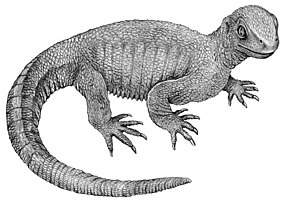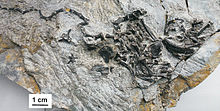Pappochelys
| Pappochelys | ||||||||||||
|---|---|---|---|---|---|---|---|---|---|---|---|---|

Live reconstruction of Pappochelys rosinae |
||||||||||||
| Temporal occurrence | ||||||||||||
| Ladinium ( Middle Triassic ) | ||||||||||||
| 242 to 235 million years | ||||||||||||
| Locations | ||||||||||||
|
||||||||||||
| Systematics | ||||||||||||
|
||||||||||||
| Scientific name | ||||||||||||
| Pappochelys | ||||||||||||
| Schoch & Sues , 2015 | ||||||||||||
| species | ||||||||||||
|
||||||||||||
Pappochelys is an original relative of the turtle . This genus comes from the Lower Keuper von Vellberg in Baden-Württemberg and has a geological age of approximately 240 million years ( Ladinian , Middle Triassic).
description
Pappochelys was described by Rainer Schoch and Hans-Dieter Sues in 2015 . The diapside skull (two temporal windows) and the belly armor (fused gastralia ) are characteristic. The back armor, like the next younger tribe turtle Odontochelys, is still unfinished and consists only of broadened ribs. The shoulder girdle bones were not yet connected to the belly armor, while the slender shoulder blade is already very reminiscent of turtles. Pappochelys was much smaller than most Mesozoic turtle relatives; adult animals probably only reached a length of 20–30 cm.

Naming
The generic name Pappochelys combines the two ancient Greek words "pappos" (grandfather) and "chelys" (turtle). That is why the turtle was given the name “Grandpa Turtle” in the press. The species name rosinae pays tribute to Isabell Rosin , taxidermist at the State Museum for Natural History in Stuttgart , who prepared numerous finds and developed the necessary processes.
meaning
In addition to its high geological age, Pappochelys is also of general importance for the origin of the turtles and the systematics of all reptiles. It shows a completely diapsid skull structure (upper and lower temple windows, divided by clasp-like postorbital and squamosum ). Until the discovery of Pappochelys , the question was open whether turtles originally had a closed ( anapsid ) or openwork (diapsid) skull. Furthermore, Pappochelys proves that the turtle shell was largely created from pre-existing skeletal elements: the back armor from broadened ribs, the belly armor from fused gastralia ("belly ribs").
The anatomy of Pappochelys is reminiscent of early Permian diapside reptiles , which had a small head, a broadened torso, and a long oar tail. At the same time, Pappochelys has numerous diagnostic features of the turtles and is in almost all features more original than Odontochelys : the skull is even more delicate and diapsid, the front legs are shorter than the hind legs, the tail is much longer, the neural plates on the vertebrae and the gastralia are missing are not yet overgrown.
Way of life
Pappochelys can be found in clayey deposits of smaller freshwater lakes (Vellberg, Kupferzell). Most of the skeletons were deposited as spits . At Vellberg there were skeletal remains of various sizes, which indicate that both young and adult animals lived in the lake or on its banks. The thickened gastralia and broadened ribs could have made the turtle heavier (bony ballast), which could be interpreted as an adaptation to diving.
Pappochelys and the origin of the turtles
The diapside skull of Pappochelys has shown that a derivation of the turtles from the parareptiles ( procolophonians , pareiasaurs ) or other early reptiles ( captorhinomorphs ) is no longer likely. Turtles have a diapsid origin. However, the exact relationship of the turtles within the Diapsids remains unclear at first. Pappochelys has similarities with bridge lizards and basal lepidosaurs (temporal region), but these could be original features of all diapsids. Other features (pelvis, hind limbs) are reminiscent of archosauromorphs , which would be more compatible with molecular studies. It is also conceivable that turtles branched off before the separation of lepidosaurs and archosaurs.
The following cladogram shows the phylogenetic position of the Pan-Testudines and Pappochelys , based on an analysis based on the principle of maximum parsimony .
| Reptiles |
|
||||||||||||||||||||||||||||||||||||||||||||||||||||||||||||||||||
|
|
literature
- RR Schoch, HD Sues: A Middle Triassic stem-turtle and the evolution of the turtle body plan. In: Nature . 2015. doi: 10.1038 / nature14472
Individual evidence
- ^ RR Schoch, HD Sues: A Middle Triassic stem-turtle and the evolution of the turtle body plan. In: Nature . 2015. doi: 10.1038 / nature14472
- ↑ C. Li, X.-C. Wu, O. Rieppel, L.-T. Wang, L.-J. Zhao: An ancestral turtle from the LateTriassic of southwestern China. In: Nature. Volume 456, 2008. pp. 497-501
- ↑ Spectacular find near Schwäbisch Hall: Researchers discover the world's oldest turtle fossil. In: Focus Online . June 24, 2015, accessed June 25, 2015 .
- ^ Dpa, sg: Paleontology: The Grandpa Turtle from the South. In: zeit.de . June 24, 2015, accessed June 25, 2015 .
Web links
- Baden-Württemberg: Oldest turtle in the world discovered. In: Spiegel Online . June 24, 2015, accessed June 25, 2015 .
- Hanno Charisius : Paleobiology - More lizard than dinosaur. In: sueddeutsche.de . June 24, 2015, accessed June 25, 2015 .
- Oldest turtle discovered in the world. In: welt.de . June 24, 2015, accessed June 25, 2015 .
